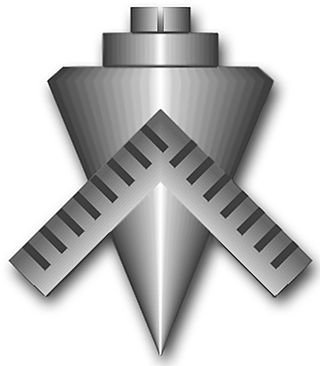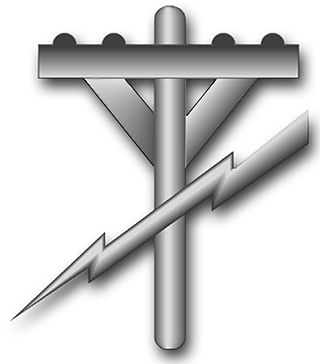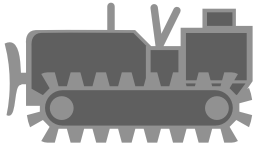
A non-commissioned officer (NCO) is a military officer who does not hold a commission. Non-commissioned officers usually earn their position of authority by promotion through the enlisted ranks. In contrast, commissioned officers usually enter directly from a military academy, officer training corps (OTC) or reserve officer training corps (ROTC), or officer candidate school (OCS) or officer training school (OTS), after receiving a post-secondary degree.
Master chief petty officer (MCPO) is an enlisted rank in some navies. It is the ninth enlisted rank in the United States Navy and United States Coast Guard, just above Senior Chief Petty Officer (SCPO). Master chief petty officers are addressed as "Master Chief " in colloquial contexts. They constitute the top 1.25% of the enlisted members of the maritime forces.

Command master chief petty officer (CMDCM) is an enlisted rating in the United States Navy and U.S. Coast Guard, as well as the Japan Maritime Self-Defense Force.

The Master Chief Petty Officer of the Navy is a unique non-commissioned rank and position of office of the United States Navy, which is designated as a special paygrade above E-9. The holder of this position is the most senior enlisted member of the U.S. Navy, equivalent to the Sergeant Major of the Army, Chief Master Sergeant of the Air Force, Sergeant Major of the Marine Corps, Master Chief Petty Officer of the Coast Guard, and Chief Master Sergeant of the Space Force. The holder of this rank and position is the most senior enlisted sailor in the Navy, unless an enlisted sailor is serving as the Senior Enlisted Advisor to the Chairman. The current MCPON is James Honea.
A petty officer (PO) is a non-commissioned officer in many navies and is given the NATO rank denotation OR-5 or OR-6. In many nations, they are typically equal to a sergeant in comparison to other military branches. Often they may be superior to a seaman, and subordinate to more senior non-commissioned officers, such as a chief petty officers.

A chief master sergeant is the military rank for a senior non-commissioned officer in the armed forces of some countries.
A United States military occupation code, or a military occupational specialty code, is a nine-character code used in the United States Army and United States Marine Corps to identify a specific job. In the United States Air Force, a system of Air Force Specialty Codes (AFSC) is used. In the United States Navy, a system of naval ratings and designators are used along with the Navy Enlisted Classification (NEC) system. A system of ratings is also used in the United States Coast Guard.

The Meritorious Service Medal (MSM) is a military award presented to members of the United States Armed Forces who distinguished themselves by outstanding meritorious achievement or service to the United States subsequent to January 16, 1969.

Builder is a United States Navy occupational rating. A builder is responsible for the construction and repair of wood, concrete, and masonry structures. Their work can involve sheet rock, ceramic tile, or painting, while senior personnel deal with material estimates and labor projections. Builders also conduct the Navy's combat and disaster preparedness operations.

Construction electrician is a United States Navy occupational rating.

Construction mechanic is a United States Navy occupational rating.

Engineering aide is a United States Navy occupational rating.

Equipment operator is a United States Navy occupational rating.

Utilitiesman is a United States Navy occupational rating.
Chief Petty Officer (CPO) is the seventh enlisted rank in the United States Navy and U.S. Coast Guard, just above Petty Officer First Class and below Senior Chief Petty Officer. The term "rating" is used to identify enlisted job specialties. In this way, enlisted personnel are segregated into three segments containing different enlisted ranks. Furthermore, rates are broken down into three levels: non-rated members without a designated occupation. Advancement to E-4 and above is dependent on graduating from a specialty school that define what the enlisted is rated for. Petty officers and chief petty officers are part of the rated force and considered extremely knowledgeable about their particular rating. Examples include Culinary Services Chief and Aviation Maintenance Chief. The Chief Petty Officer is the rank. Gunners Mate is a rating. E7 is a pay grade. The term rating is used to identify the career field of a chief petty officer. For example, the title of a chief petty officer in the Master-at-Arms rating would be spoken or spelled out as Master-at-Arms, Chief Petty Officer or Chief Master-at-Arms. The title would be abbreviated MAC. The grade of chief petty officer was established on 1 April 1893 in the United States Navy. The United States Congress first authorized the Coast Guard to use the promotion to Chief Petty Officer on 18 May 1920. Chief petty officer is also the final cadet grade in the United States Naval Sea Cadet Corps.

The Master-at-Arms (MA) rating is responsible for law enforcement and force protection in the United States Navy—equivalent to the United States Army Military Police, the United States Marine Corps Military Police, the United States Air Force Security Forces, and the United States Coast Guard's Maritime Law Enforcement Specialist. It is one of the oldest ratings in the United States Navy, having been recognized since the inception of the U.S. Navy.













